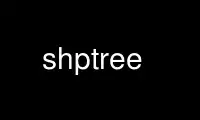
This is the command shptree that can be run in the OnWorks free hosting provider using one of our multiple free online workstations such as Ubuntu Online, Fedora Online, Windows online emulator or MAC OS online emulator
PROGRAM:
NAME
shptree - create a quadtree-based spatial index for a Shape data set
SYNOPSIS
shptree [ shpfile [depth] [index_format] | -v]
DESCRIPTION
shptree creates a quadtree-based spatial index for a Shape data set. The default tree
depth is calculated so that each tree node (quadtree cell) contains 8 shapes. Do not use
the default with point files, a value between 6 and 10 seems to work ok. Your millage may
vary and you'll need to do some experimenting.
This utility is a must for any MapServer application that uses Shape data sets. shptree
creates a spatial index of your Shape data set, using a quadtree method. This means that
MapServer will use this index to quickly find the appropriate shapes to draw. It creates a
file of the same name as your Shape data set, with a .qix file extension. The quadtree
method breaks the file into 4 quadrants, recursively until only a few shapes are contained
in each quadrant. This minimum number can be set with the depth parameter of the command.
OPTIONS
shpfile
The name of the .shp file to index.
depth (Optional) The maximum depth of the index to create, default is 0 meaning that
shptree will calculate a reasonable default depth.
index_format
(Optional) One of:
NL LSB byte order, using new index format
NM MSB byte order, using new index format
The following old format options are deprecated:
N Native byte order
L LSB (intel) byte order
M MSB byte order
The default index_format on this system is: NL
-v Display mapserver version and build options.
NOTES
Shape data sets are native to MapServer, and therefore do not require the .shp extension
in the DATA path of the LAYER. In fact, in order for MapServer to use the .qix extension
you MUST NOT specify the extension, for example:
LAYER
...
DATA "us_states" #MapServer will search for us_states.qix and will use it
...
END
LAYER
...
DATA "us_states.shp" #MapServer will search for us_states.shp.qix and won't find it
...
END
Note: As of MapServer 5.2 the qix will be used even when the .shp extension is specified.
EXAMPLE
shptree us_states.shp
creating index of new LSB format
Result:
A file named 'us_states.qix' is created in the same location. (note that you can
use the shptreevis(1) utility to view the actual quadtree quadrants that are used
by MapServer in this qix file)
Use shptree online using onworks.net services
